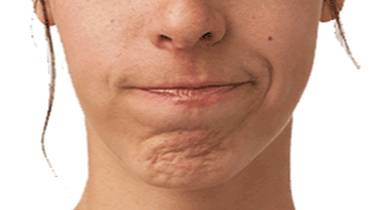Cobblestone Chin Treatment with Botox - Dr Yeung 楊浩康

Botulinum Toxin Injections Can Effectively Improve a Cobblestone Chin
Causes of a Cobblestone Chin:
A cobblestone chin typically occurs because the mentalis muscle in the chin has an excessive number of fibrous attachments to the dermis. These fibrous connections cause the mentalis muscle’s movements to pull on the dermis more aggressively, resulting in an uneven chin surface with irregular depressions and protrusions that resemble a “cobblestone” pattern. As one ages and skin elasticity decreases, this phenomenon may become more pronounced, affecting the overall smoothness and aesthetic appeal of the face.
Explanation of the Treatment Mechanism:
1. Effect of Botulinum Toxin: Botulinum toxin works by blocking the transmission of signals between nerves and muscles, which causes the mentalis muscle to temporarily relax. This relaxation reduces the uneven traction on the dermis, thus smoothing the surface of the chin for a more natural appearance.
2. Injection Technique: Since the mentalis muscle is located in a deep layer of the chin, it is crucial that the injection is accurately administered into the deep muscle rather than the subcutaneous tissue. Precision in injection technique and proper dosage control are essential for ensuring treatment efficacy and minimizing the risk of side effects.
Prevalence Among Asian Populations:
A cobblestone chin is relatively common among Asian populations due to genetic factors and variations in facial muscle structure. Additionally, Asian aesthetics often favor delicate and refined facial contours, which has made this treatment a popular choice for those seeking to smooth out irregularities in the chin and achieve a more refined appearance.
Combination Therapy:
To achieve optimal aesthetic results, botulinum toxin injections are often combined with filler treatments, such as hyaluronic acid. The toxin relaxes the mentalis muscle, reducing the wrinkling caused by muscle activity, while the filler helps to restore volume in uneven areas of the chin. This combination provides a more balanced, smooth, and long-lasting improvement in the chin’s appearance.
Side Effects and Precautions:
1. Potential Side Effects: Common side effects may include drooling, speech difficulties, mouth asymmetry, and lower lip drooping. Although these side effects are generally temporary, they emphasize the importance of precise injection techniques.
2. Methods to Reduce Side Effects: To minimize the risk of adverse effects, physicians often use lower doses or apply more precise injection techniques. Additionally, close post-treatment observation and timely medical intervention are important to manage any discomfort or complications that may arise.
Professional Recommendations:
Due to the complex anatomy of the mentalis muscle and its deep location, it is highly recommended that these injections be administered by an experienced and skilled practitioner. A thorough facial evaluation is typically performed before each treatment to determine the best treatment plan and optimal injection points, ensuring a customized approach based on the individual's facial structure and muscle activity.
Long-Term Considerations:
While botulinum toxin injections can effectively improve a cobblestone chin, the results are temporary and usually require regular repeat treatments to maintain the desired outcome. For those seeking longer-lasting and more significant improvements, alternative surgical options such as chin contouring or other minimally invasive reshaping procedures may be considered.
